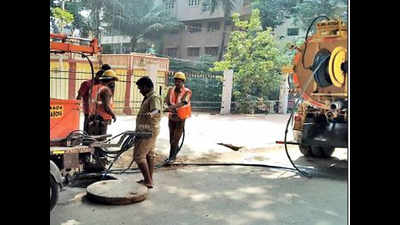- News
- City News
- bengaluru News
- Bengaluru: 40,000 manholes cleaned ahead of monsoon
Trending
This story is from May 20, 2019
Bengaluru: 40,000 manholes cleaned ahead of monsoon
With monsoon set to arrive next month, civic agencies are working on a war footing to implement preventive steps to ensure the city is spared flooding and waterlogging.

BWSSB will purchase 31 more jetting machines to speed up the massive cleaning exercise
BENGALURU: With monsoon set to arrive next month, civic agencies are working on a war footing to implement preventive steps to ensure the city is spared flooding and waterlogging.
The Bangalore Water Supply and Sewage Board (BWSSB) has taken up the task of cleaning all 2.4 lakh manholes in Bengaluru and has completed work on around 40,000 of them.

Announcing the plan to clean the manholes, BWSSB chairman Tushar Girinath set a timeline of 18 months to achieve the target.Admitting that the manholes hadn’t been cleaned for several years, he said the work began on January 1.
Confirming that 40,000 manholes had already been cleaned, BWSSB chief engineer Gangadhar BC said: “It’s difficult to clean 2.4 lakh manholes within a few months. We have chalked out an 18-month plan and 7,000-8,000 manholes can be cleaned in a month,” he said.
He said manholes in areas like JC Road, Raj Bhavan Road, Balabruhi, High Grounds and surrounding VVIP roads have been cleaned and directions have been issued to divisional and sub-divisional engineers to ensure flooding is averted in low-lying areas.
Gangadhar said they have deployed all 139 jetting machines for the cleaning exercise. As the number of machines is less given the size and spread of Benglauru, the utility has decided to purchase 31 more machines, which will join the fleet over the next fortnight.
“The idea to take up this massive cleaning exercise came following complaints about overflowing manholes, especially during monsoon. As our jetting machines are equipped with GPS, all manholes are being tracked. The drivers and engineers cannot fool anybody,” Girinath added.
The Bangalore Water Supply and Sewage Board (BWSSB) has taken up the task of cleaning all 2.4 lakh manholes in Bengaluru and has completed work on around 40,000 of them.

Announcing the plan to clean the manholes, BWSSB chairman Tushar Girinath set a timeline of 18 months to achieve the target.Admitting that the manholes hadn’t been cleaned for several years, he said the work began on January 1.
TimesView
In Bengaluru, manholes are doing everything except what they were designed to do. Clogged, they spew filth on roads. At the hint of rain, they overflow. Without covers, they are deathtraps for passersby. When covered, their tops jut above the ground and cause accidents. When poorly equipped scavengers enter the pits to fix them, they cause death. The BWSSB’s decision to clean the 2.4 lakh manholes in the city was long awaited, yet the pace at which work is progressing does not inspire confidence. With an 18-month deadline to fix them all, it is clear Bengalureans will have to live with the flawed pits not just this monsoon, but next year as well.
Confirming that 40,000 manholes had already been cleaned, BWSSB chief engineer Gangadhar BC said: “It’s difficult to clean 2.4 lakh manholes within a few months. We have chalked out an 18-month plan and 7,000-8,000 manholes can be cleaned in a month,” he said.
He said manholes in areas like JC Road, Raj Bhavan Road, Balabruhi, High Grounds and surrounding VVIP roads have been cleaned and directions have been issued to divisional and sub-divisional engineers to ensure flooding is averted in low-lying areas.
Gangadhar said they have deployed all 139 jetting machines for the cleaning exercise. As the number of machines is less given the size and spread of Benglauru, the utility has decided to purchase 31 more machines, which will join the fleet over the next fortnight.
“The idea to take up this massive cleaning exercise came following complaints about overflowing manholes, especially during monsoon. As our jetting machines are equipped with GPS, all manholes are being tracked. The drivers and engineers cannot fool anybody,” Girinath added.
End of Article
FOLLOW US ON SOCIAL MEDIA










